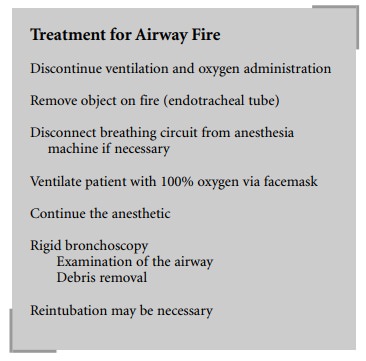Chapter: Clinical Cases in Anesthesia : Laser Laryngoscopy
What maneuvers are instituted to treat an airway fire? Is the risk of fire any less likely with electrocautery?
What maneuvers are instituted to treat an airway fire? Is the risk
of fire any less likely with electro-cautery?
The first person to recognize an airway fire
will proba-bly be the surgeon. The surgeon must notify the anesthesi-ologists
immediately, who should cease ventilation
and discontinue oxygen administration
to eliminate the source of
combustion. In some circumstances, it may be necessary to disconnect the
breathing circuit from the anesthesia machine. The flaming material must be
removed from the airway and placed in a bucket of water, which should always be
available for this purpose. Designated CO2 fire extinguishers are
also recommended. Immediately after removal of the tube, ventilate the patient
with 100% oxy-gen by face mask and continue the anesthetic. Debris removal and
airway examination are performed with a rigid bronchoscope. An airway burn
requires reintubation to protect against potential airway obstruction from
edema. On occasion, tracheostomy, bronchopulmonary lavage, or fiberoptic
tracheobronchoscopy may be indi-cated. If the injury is severe, prolonged
intubation and mechanical ventilation may be necessary, along with a course of
high-dose steroids and antibiotics when cultures are positive. The long-term
sequelae of burns may take weeks to manifest.
Electrocautery fire is no less risky than laser
fire.
Electrocautery fire may even be more common.

Related Topics